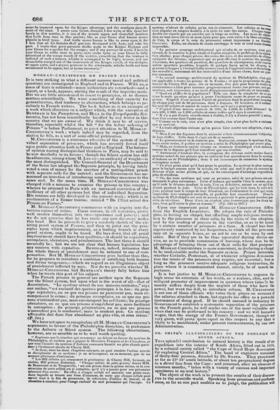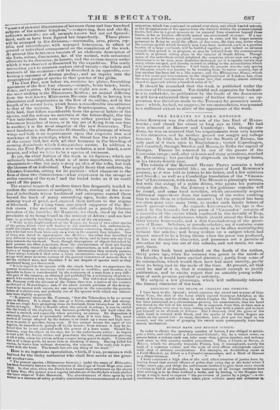DR. SMITH'S ILLUSTRATIONS OF THE ZOOLOGY 01 SOUTH AFRICA.
THIS splendid contribution to natural history is the result of an expedition into the interior of South Africa, fitted out in 1836, by a colonial society called "the Cape of Good Hope Association for exploring Central Africa." The band of explorers consisted of thirty-four persons, directed by Dr. SMITH. They penetrated as far as 23° 28' south latitude, or about ten geographical degree in a direct line from the Cape; and returned, after an absence of nineteen months, "laden with a variety of curious and important specimens in natural history." The object of the work is to present the results of their discove- ries to the scientific world. Speaking from promises and pesters! - am°, so far as one part enables us to judge, the publication Will "consist of pictorial illustrations of.between three and four hundred subjects of the animal kingdom,' —comprising, first and chiefly, unknown animals ; sec,nd, animals known but not vet figured ; third, such as have been figured but imperfectly. These plates will be arranged in five divimons,—mantmalia, ayes, places, rep- and invertebrate-1% . with unpaged letterpress, to admit of general or inddual arrangement on the completion of the work. At present this letterpress consists of an elaborate description of the form, colour, dimensions, Sec. of the animal, with occasional allusions to its character, its haunts, and the circumstances under which it was observed or discovered by the expedition. The really interesting part to nineteen readers out of twenty—the habits and manners of the creatures—w
ill be described in an appendix, con- taining a summary of African geoloey, and an inquiry into the geographical ranges of species in that quarter of the globe. The First art, now before us, contains ten plates, furnishing P
specimens of the first four classes,—namely, brute beasts, birds, fishes, and reptiles. Of these seven or eight are new. Amongst the most striking is the Rhinoceros Keitloa; an animal differing from tile well-known Rhinoceros Bicornis chiefly in having less clumsiness and angularities in the flow of its outline, and in the length of its second horn, which bears a considerable resemblance to that of the unicorn. The Falco Semitorquatus, an elegant little bird, that differs considerably from the general habits of the species, and the notions we entertain of the falcon-flight, (for the "few individuals that were seen were either perched upon the lowermost branches of trees, or in the act. of fly log from one tree to another,") is the most singular of the new discoveries. The most handsome is the Pterocles Gutteralis; the plumage of whose wings and body is an improvement upon the exquisite hue and markings of the partridge, whilst its throat has the rich yellow of the canary bird, but with all that harmony in the blending of seeming discordents which distinguishes nature. In addition to these, the First Part presents a new cockatoo, a new lizard, a new serpent, and what we tel:e to be a species of eurassow.
As yet, the chief feature of the work is its figures ; which are sufficiently beautiful, and, what is of more importance, strongly characteristic—they not only ciavey an idea of the tribe, but look the likeness of an individual. One might fancy that cockatoo, the Chizteris Conculor, sitting for its portrait : what character in the form of those two rhinoceroses—what expression in the savage or sullen cunning of the eyes and the lizard looks as if lie could crawl off the paper. -
The exacter research of modern times has frequently tended to confirm the statements of antiquity, which, resting on the asser- tion of individuals whose hardihood and enterprise carried them beyond the track of many succeeding ages, broke down from seeming want of proof, and exposed their authors to the stigma of falsehood. For a long time, one grand supporter of the Bri- tish crown (the unicorn) was ridiculed as a purely fabulous invention of the heralds; till Battenw, we think, stood up for the possibility of its being found in the interior of Africa : and see how time is gradually tending towards proof of its existence. " While in the neighbourhood of the Ts opie, we heard of two other species of the genus, which exist still further to the northward ; but, unfortunately, could not obtain any very circumstantial evidence concerning them, as the per- sons who had seen them were only ou a visit in the country they inhabit. One of them was stated to appoximate the .Ked/oo; the other was described as very different to any species previously seen by them, and to have only one long horn towards the forehead. Now, though descriptions of objects furnished by such persons are often inaccurate, from the circumstance of their not having been favourably situated for makirg correct observations, as well as from a de- ficiency of language calculated to convey the information they actually possess, I have always miliaria d that even a hasty examination seemed to supply the savage with more accurate notions of the general characters of animals than it did the civilized man, and therefore 1 do not despair of species such as they mentioned being yet discovered. " It is in regard to the species with the single horn that we experience the greatest hesitation in receiving their evidence as credible; and therefore it is agreeable to have it corroborated by the testimony of a man from a very diffe- rent part of the country, as obtained and published by a missionary of great re- search who resided a long time in Madagascar. The individual who furnished Mr. Freeman with the account of the Ndzoo-dzou was a native of the country northwaid of Mozambique; and, if we admit certain portions of the descrip- tions to be tainted with errors, we can recognize in the remainder the genuine habits of a rhinoceros, and probably one of the species with which our inform- ants were slightly acquainted. " ' It appears,' observes Mr. Freeman, ' that the Ndzoo-dzoo is by no means rare in Makooa. It is about the size of a horse, extremely fleet and strong. It has one single horn projecting from its forehead, from twenty-four to thirty inches in length. This is flexible when the animal i9 asleep; it can be curled like the trunk of the elephant, but becomes perfectly firm and hard when the animal is excited, and especially when pursuing an enemy. Its disposition is extremely fierce, and it universally attacks man if it sees him. The usual method of escape adopted by the natives is to climb up a dense and high tree, so as to avoid, if possible, being seen. If the animal misses his sight of the fugitive, he immediately gallops off to his haunt ; from whence it may be in- fend that he is not endowed with the power of a keen scent. Should he, however, espy his object in the tree, wo to the unfortunate native : he begins to butt with his horns, strikes and penetrates the tree, and continues piercing it till it falls, when his victim seldom escapes being gored to death. Unless the tree is of a large girth, he never fails in breaking it down. Having killed his victim, he leaves him without devouring the carcase. The male only is pro- vided with the horn. The female has hot any thing of the kind.'" Here is an ingenious speculation, which, if true, promises a rich harvest for the lucky naturalist who shall first arrive at the gene- ral rendezvous. " The present species, (Rhinoceros hicornis,) under the name of Rhinoster, hos been familiarly known to the colonists of the Cape of Good Hope ever since 1652. In that year, when the Dutch first formed their settlement on the shores of Table Bay, this animal was a regular inhabitant of the thickets which clothed the lower elopes of Table Mountain. The ahandonmtnt of those spots by this Animal as a measure of safety probably constituted the counueaceineut of a formal migration, which has continued to extend ever since, and which hauled not only to the disappearance of the species from the districts within the present colonial limits, but also in a great measure to its removal from countries beyond those limits, as far as hunters efficiently armed are accustomed to resort. If a sys- tem such as has hitherto prevailed continues to exist, and the larger animals persevere in ffr,ing to avoid the effects of fire-arms, the time may arrive when the various species which formerly may have been scattered, each in a peculiar locality of a large continent, will be huddled together ; awl indeed an advance towards that period is in progress, as may be inferred from the concentration which is at present taking place in the interior of South Africa. Though many of the individuals which inhabited the countries where now not a single rhinoceros is to he seen, were doubtless destroyed, yet it is equally certain that many others escved, and thereby assisted in adding to the accumulation tvhich is in progress in other localities. Until lately the present was the only species of the genus which was known to be receding from its native country, but of late another has been led to a like course; and the Rhinoceros Shuns, which but a few years ago was common in the neighbourhood of Latakoo, has, since the more general introduction of fire-arms into that country, almost entirely ceased to approach within a hundred miles of it."
It should be remarked that the work is published under the auspices of Government. Too riskful and expensive for booksel- le s to undertake, its publication by the funds of the Association weaild have exhausted their means of further discovery : an ap- Oration was therefore made to the Treasury for pecuniary assist- anee ; w hich, backed, we suppose, by recommendation, was granted to a sufficient extent to allow of the appearance of the work.



























 Previous page
Previous page